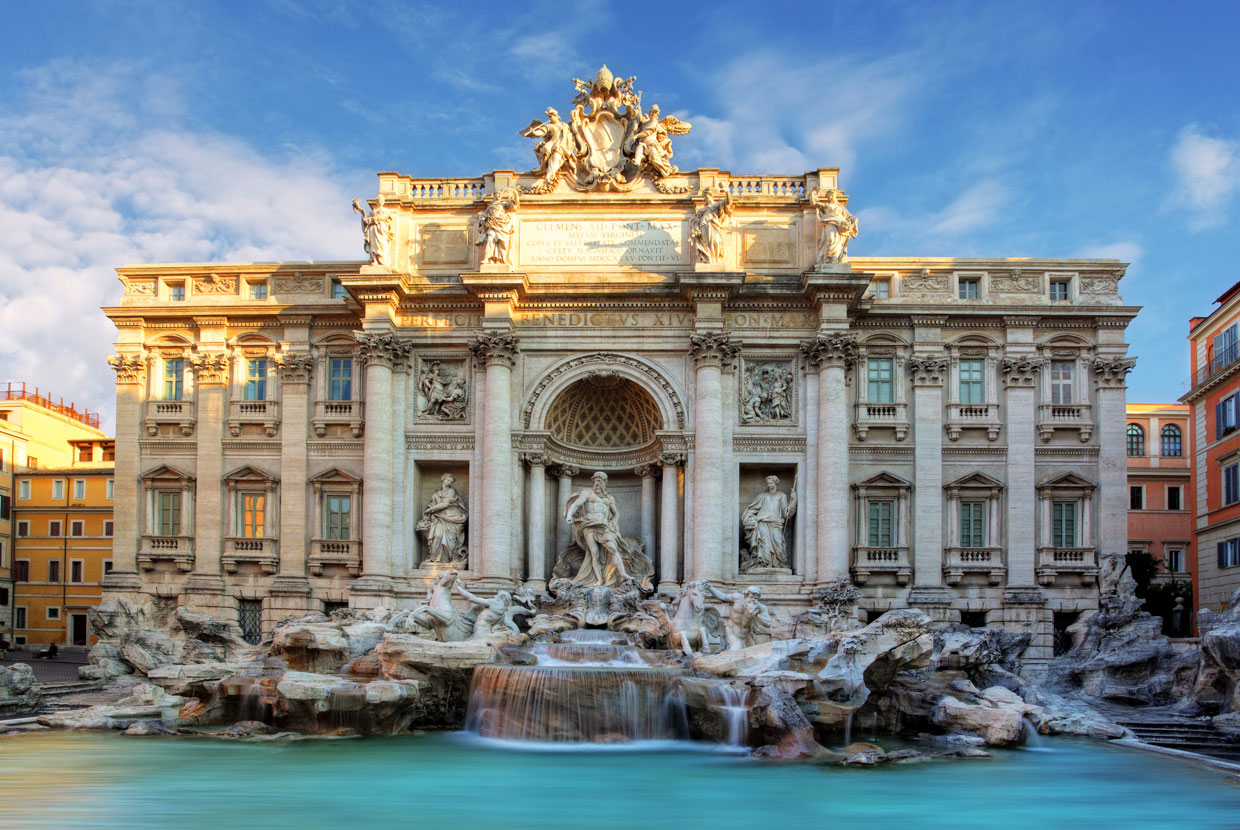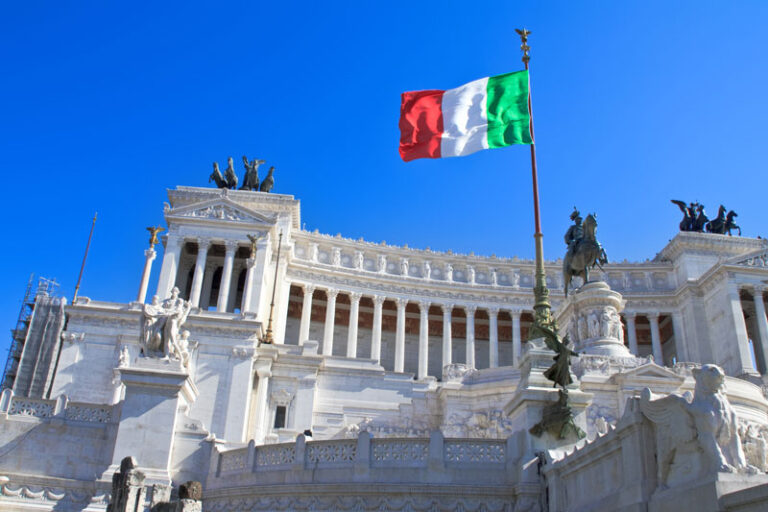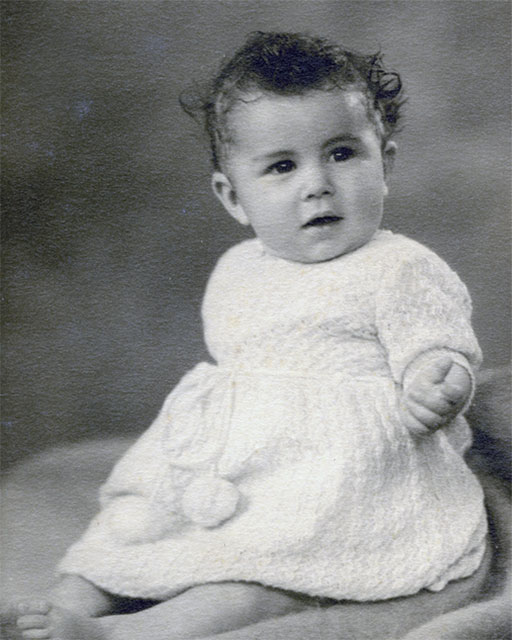
Rome is famous for ancient remnants and artistic architecture but Trevi Fountain is arguably one of the most impressive landmarks in the entire city. Featuring some beautifully carved stonework and gushing water, this stunning water feature attracts millions of visitors each year.
While Fontana di Trevi was just one of thousands of fountains in 4th century Rome, this famous water feature was always known as the most spectacular. At the same time, while this attractions is best known for having a unique experience, there is much intrigue and history behind the fountain.
Situated in the Quirinale district, Trevi Fountain stands at just over 26 metres high and stretches for no less than 49 meters in width. In fact, Trevi Fountain is the biggest baroque fountain in Rome and the water comes from Salone Springs which is more than 14 miles from the city center.
And that’s just part of the story…..
The Incredible History of Trevi Fountain in Rome
You see, Fontana di Trevi has quite a fascinating and colorful history.
In case you might be asking yourself, many historians believe that the name this fountain derives from the Latin word “trivium” which means three streets. For this reason, “Trevi Fountain” simply translates as “Three Street Fountain” which explains the location of the fountain at the junction of three separate roads.
However, Trevi Fountain would not exist only for the Aqua Virgo aqueduct which was built in 19 BC by Agrippa – the son-in-law to Augustus. Aqua Virgo was initially built to supply water to the Roman Baths in Ancient Rome and so the fountain was positioned at the very end of this aqueduct.
With this in mind, the fountain was not so spectacular back in 1629, when Pope Urban VIII was noted as saying the fountain lacked any real drama. As a result, the Pope requested a famous architect called Bernini to re-design the feature but these efforts were abandoned upon the death of Pope Urban.
In the next century, Pope Clement XII created a contest in which the winner would land the commission for redesigning Trevi Fountain. Although Alessandro Galilei from Florence won this contest, the Romans were outraged and a Roman architect named Salvi was given the important job.
Of course, Nicola Salvi was a Roman and went about creating a new theme for the fountain called “Taming of the Waters”. Travertine, a form of limestone, was used to create the facade and the statues around the fountain were created with Carrara marble.
Unfortunately, Salvi also passed away before the completion of the new Trevi Fountain. After being designed by Nicola Salvi, the construction of this famous fountain was eventually carried out by Giuseppe Pannini and the project was finished in 1762.
In more recent times, Trevi Fountain was the subject of a refurbishment effort by a fashion house called “Fendi” which cost an incredible $2.2 million. It took seventeen months to complete this restoration in which the facade was cleaned, new pumps were installed and Latin inscriptions were replaced. As a result, the fountain was reopened in 2015 and is now looking even more impressive than ever.
About the Statues at Trevi Fountain
As with every great piece of art, Trevi Fountain tells a story and each statue is symbolic of a unique and interesting concept. Here is a brief explanation of the three main statues – Oceanus, Abundance and Health.
Oceanus – Standing under the arch at the center of Trevi Fountain, Oceanus and his chariot are being pulled by two sea-horses. One is docile and the other wild, which represents the moods of the sea. There are also two tritons in front of the sea-horses, with the older triton announcing the passage.
Abundance – To the left of the arch, Abundance holds a horn and stands over a toppled vase which lies at her feet. Meanwhile, the relief above shows Agrippa instructing his men to construct the aqueduct.
Health – To the right of the arch, Health wears a wreath-crown and holds a cup in her hand, from which a snake is drinking. The relief above illustrates a virgin lady informing soldiers about the source of the water.
Above these main statues, you can also see four smaller statues near the top of the fountain. As a rule, these statues symbolize the fertility of earth in the following ways:
Abundance of Fruit – This statue is holding a horn.
Fertility of Crops – This statue holds ears of wheat.
Products of Autumn – This statue holds a cup with grapes.
Joy of the Gardens – This statue is covered in flowers
Famous Ritual: Tossing Coins into Trevi Fountain
You will likely notice every other tourist tossing a coin or several coins into Trevi Fountain. For many visitors, this tradition originates with an American movie called “Three coins in the fountain” in which three ladies went in search of love in the eternal city.
The first coin is said to ensure a quick return to Rome, the second brings about romance and the last is the promise of marriage. Also, there is a ritual to this process in which you should stand with your back to the fountain and toss each coin over your left shoulder.
That being said, it’s also believed that this tradition dates back to Ancient Rome when drinking a cup of water and tossing a coin into Trevi Fountain would bring great fortune.
Some Last Minute Tips for Visiting the Trevi Fountain
Night and Day – Do yourself a favor and visit Trevi Fountain during the day and also after dark. While you can see the fountain much better in daylight, it looks spectacular when lit up at night.
Pickpockets – Due to the large crowds, there is sometimes the occasional petty thief in the mix. However, you can expect no trouble and this is just more of a warning to keep your bags zipped tight and cameras wrapped safely around your neck.
Avoiding Tourists – The truth is, crowds are hard to avoid at Trevi Fountain but your best opportunity is likely to be sunrise, when there is often much less people about.
Trevi Fountain Resources:
- The Origin of the Trevi Fountain Coin Tradition
- Trevi Fountain – Don’t drink the water
- The Trevi Fountain Digital Library
- Trevi Fountain: Overall view of fountain with the facade of Palazzo Poli
- Trevi Fountain: Library of Congress
- Fountain of Trevi, Rome, Italy
Final Thoughts
Trevi Fountain is an absolute masterpiece and a must-see on any visit to the Eternal City. While you may or may not believe the coin-tossing superstition, this is also quite a magical encounter and an opportunity to admire some of the finest baroque architecture from Ancient Rome. If you want to experience this masterpiece anytime you want and believe you may meet the Italian citizenship requirements, contact us to speak with our citizenship team.
However, if you want to beat the crowds and enjoy convenient access to Trevi Fountain, you should buy tickets in advance. More specifically, this is always cheaper than what you get after waiting in line and a great way to ensure that visiting these busy attractions does not interrupt your travel itinerary.





